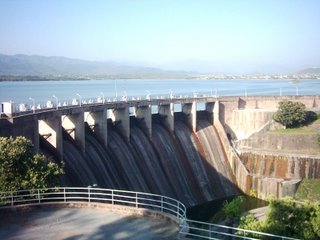
Last part
Run-of-the-river hydroelectricity is ideal for streams or rivers with a minimum dry weather flow or those regulated by a much larger dam and reservoir upstream. A dam, smaller than that used for traditional hydro, is required to ensure that there is enough water to enter the “penstock” pipes that lead to the lower-elevation turbines. Projects with poundage, as opposed to those without poundage, can store water for peak load demand or continuously for base load, especially during wet seasons. In general, projects divert some or most of a rivers flow (up to 95% of mean annual discharge) through a pipe and/or tunnel leading to electricity-generating turbines, then return the water back to the river downstream.
ROR projects are dramatically different in design and appearance from conventional hydroelectric projects. Traditional hydro dams store enormous quantities of water in reservoirs, necessitating the flooding of large tracts of land. In contrast, most run-of-river projects do not require a large impoundment of water, which is a key reason why such projects are often referred to as environmentally-friendly, or “green power.”
The use of the term “run-of-the-river” for power projects varies around the world and is dependent on different definitions. Some may consider a project ROR if power is produced with no storage while a limited storage is considered by others. Developers may mislabel a project ROR to sooth public image about its environmental or social effects. A power station utilizing the run of the river flows for generation of power with sufficient poundage for supplying water for meeting diurnal or weekly fluctuations of demand. In such stations, the normal course of the river is not materially altered.
The Technology:
Hydroelectric power, or hydro power, is electricity generated from the energy of moving water. There are several types of hydroelectric facility, including impoundments, run-of-river and pumped storage. Impoundments and run-of-river projects are both powered by the kinetic energy of flowing water. However impoundments use large reservoirs to restrict the flow of water while run-of-river projects use the natural flow of waterways. A pumped storage hydro facility produces electricity by moving water between reservoirs at different elevations during peak times. In all three cases, water is usually fed either from a reservoir or the natural flow of a river into a turbine which is installed at the bottom of the dam. When water is released from a height onto the turbines, pressure causes the turbine blades to rotate. This in turn moves a shaft which is connected to an electrical generator which converts the kinetic energy of water into electrical energy. The energy produced primarily depends on the volume of water and the height difference between the water source and the turbines.
Pakistan had a total installed power generation capacity of almost 23 GW in 2013. However, dependable or de-rated capacity is in the range of 16 to 18 GW during the year, due to variety of factors, whereas demand for electricity is increasing at an average annual rate of eight per cent. And according to World Energy Statistics 2011, published by IEA, Pakistans per capita electricity consumption is one-sixth of the World Average. World average per capita electricity consumption is 2730 kWh compared to Pakistans per capita electricity consumption of 451 kWh. International Energy Agency has forecast that total electricity demand of the country will be 49,078 MW in 2025.
Pakistan has an installed electricity generation capacity of 22,797MW. The average demand is 17,000MW and the shortfall is between 4,000 and 5,000MW. Oil (35.2 per cent), hydel (29.9 per cent), gas (29 per cent), and nuclear and imported (5.8 per cent) are the principal sources. In the next 10 years, peak electricity demand is expected to rise by four to five per cent, which is roughly 1,500MW. This dismal forecast is due to a lopsided energy mix, diminishing indigenous fuel reserves, increasing circular debt and transmission hold ups. Pakistan has almost exhausted its gas reserves. Imported oils price hikes affect the budget and its constant supply cannot be guaranteed. Pakistan has the potential to meet these energy challenges through hydel power but there are political and environmental issues in building dams. Rationality demands reducing reliance on oil and going for alternatives. The development of alternatives does not happen overnight. Pakistan will have to rely on imported fuels for the interim period at a huge cost. LNG is difficult to import, using coal has environmental issues, using shale gas also has environmental issues attached with it, and wind power has transmission network challenges.
In November 2013, Prime Minister Nawaz Sharif had announced that his administration has envisioned that nuclear energy will add 40,000MW to the national grid by the year 2050 at an affordable cost. Presently, 21 thermal power stations are in service and powered by either by Furnace oil or with gas. About 26 power plants are under construction and will be powered by coal, gas or furnace oil. Ministry of Water and Power has proposed five of Run of River hydro projects with installed capacity of 8678 MW. The details of the projects are:
Suki Kinari Hydro Power project Kaghan valley, Kunhar River- 840 MW
Kotli Hydro Power project on Poonch River AJK – 100 MW
Bunji Hydro Power project Astor Distt Gilgit Baltistan – 7100 MW
Mahi Hydro Power project Jhelum River, AJK- 590 MW
Jagran – II Neelum Hydro Power project Jagran River AJK – 48 MW
Cost effective renewable energy will definitely improve Pakistans economic performance. Energy efficiency along with conservation measures can result in profitable business units. Thus, exploitation of these sources of energy can lead to poverty alleviation. Use of indigenous renewable resources can help Pakistan in diversifying its energy mix. This will reduce the countrys dependence on any single source, particularly imported fossil fuel. Local environmental and health hazards introduced by fossil fuel powered electricity generation plants can be largely circumvented through clean renewable energy alternatives.